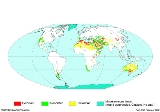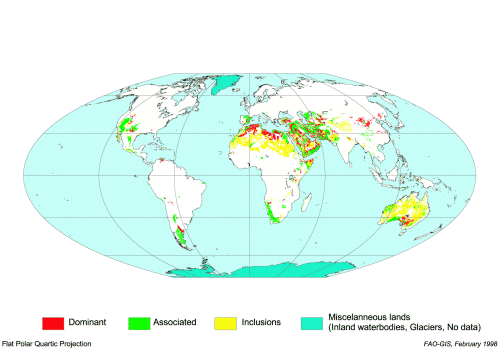
Calcisols
Encyclopedia

Fão
Fão is a town in Esposende Municipality in Portugal....
World Reference Base for Soil Resources
World Reference Base for Soil Resources
The World Reference Base for Soil Resources is the international standard taxonomic soil classification system endorsed by the International Union of Soil Sciences . It was developed by an international collaboration coordinated by the International Soil Reference and Information Centre and...
is a soil with a substantial secondary accumulation of lime. Calcisols are common in calcareous
Calcareous
Calcareous is an adjective meaning mostly or partly composed of calcium carbonate, in other words, containing lime or being chalky. The term is used in a wide variety of scientific disciplines.-In zoology:...
parent material
Parent material
In soil science, parent material is the underlying geological material in which soil horizons form...
s and widespread in arid
Arid
A region is said to be arid when it is characterized by a severe lack of available water, to the extent of hindering or even preventing the growth and development of plant and animal life...
and semi-arid
Semi-arid
A semi-arid climate or steppe climate describes climatic regions that receive precipitation below potential evapotranspiration, but not extremely...
environments. Formerly Calcisols were internationally known as Desert soils and Takyrs.
Calcisols are developed in mostly alluvial, colluvial
Colluvium
Colluvium is the name for loose bodies of sediment that have been deposited or built up at the bottom of a low-grade slope or against a barrier on that slope, transported by gravity. The deposits that collect at the foot of a steep slope or cliff are also known by the same name. Colluvium often...
and aeolian deposits of base
Base (chemistry)
For the term in genetics, see base A base in chemistry is a substance that can accept hydrogen ions or more generally, donate electron pairs. A soluble base is referred to as an alkali if it contains and releases hydroxide ions quantitatively...
-rich weathering
Weathering
Weathering is the breaking down of rocks, soils and minerals as well as artificial materials through contact with the Earth's atmosphere, biota and waters...
material. They are found on level to hilly land in arid and semi-arid regions. The natural vegetation is sparse and dominated by xerophytic shrubs and trees and/or ephemeral grasses.
Dryness, and in places also stoniness and/or the presence of a shallow petrocalcic horizon
Horizon
The horizon is the apparent line that separates earth from sky, the line that divides all visible directions into two categories: those that intersect the Earth's surface, and those that do not. At many locations, the true horizon is obscured by trees, buildings, mountains, etc., and the resulting...
, limit the suitability of Calcisols for agriculture. If irrigated, drained (to prevent salinisation
Salt
In chemistry, salts are ionic compounds that result from the neutralization reaction of an acid and a base. They are composed of cations and anions so that the product is electrically neutral...
) and fertilised
Fertilisation
Fertilisation is the fusion of gametes to produce a new organism. In animals, the process involves the fusion of an ovum with a sperm, which eventually leads to the development of an embryo...
, Calcisols can be highly productive under a wide variety of crops. Hilly areas with Calcisols are predominantly used for low volume grazing of cattle
Cattle
Cattle are the most common type of large domesticated ungulates. They are a prominent modern member of the subfamily Bovinae, are the most widespread species of the genus Bos, and are most commonly classified collectively as Bos primigenius...
, sheep and goat
Goat
The domestic goat is a subspecies of goat domesticated from the wild goat of southwest Asia and Eastern Europe. The goat is a member of the Bovidae family and is closely related to the sheep as both are in the goat-antelope subfamily Caprinae. There are over three hundred distinct breeds of...
s.
Many Calcisols occur together with Solonchaks that are actually salt-affected Calcisols and/or with other soils with secondary accumulation of lime that do not key out as Calcisols. The total Calcisol area may well amount to some 10 million square kilometres, nearly all of it in the arid and semi-arid (sub)tropics of both hemispheres.

